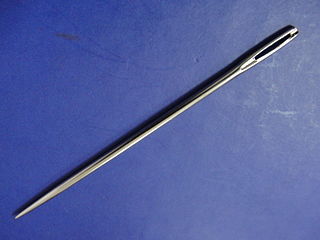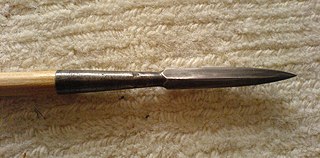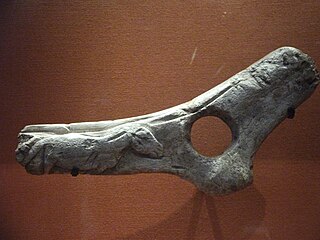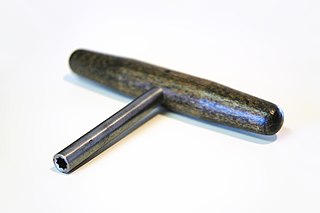
A loom is a device used to weave cloth and tapestry. The basic purpose of any loom is to hold the warp threads under tension to facilitate the interweaving of the weft threads. The precise shape of the loom and its mechanics may vary, but the basic function is the same.

An arrow is a fin-stabilized projectile launched by a bow. A typical arrow usually consists of a long, stiff, straight shaft with a weighty arrowhead attached to the front end, multiple fin-like stabilizers called fletchings mounted near the rear, and a slot at the rear end called nock for engaging the bowstring. A container or bag carrying additional arrows for convenient reloading is called a quiver.

A ferrule is any of a number of types of objects, generally used for fastening, joining, sealing, or reinforcement. They are often narrow circular rings made from metal, or less commonly, plastic. Ferrules are also often referred to as eyelets or grommets within the manufacturing industry.

A speargun is a ranged underwater fishing device designed to launch a tethered spear or harpoon to impale fish or other marine animals and targets. Spearguns are used in sport fishing and underwater target shooting. The two basic types are pneumatic and elastic. Spear types come in a number of varieties including threaded, break-away and lined. Floats and buoys are common accessories when targeting larger fish.
A crochet hook is an implement used to make loops in thread or yarn and to interlock them into crochet stitches. It is basically a round shaft pointed on one end, with a lateral groove behind it. The point eases the insertion of the hook through the material being crocheted and the groove makes it possible to pull a loop back through the material. The shaft is then divided into a working area that determines the hook's nominal diameter and ensures the uniform sizing of the loops formed on it, and a handle.

A dobby loom, or dobbie loom, is a type of floor loom that controls all the warp threads using a device called a dobby. The word dobby is a corruption of "draw boy," which refers to the weaver's helpers who used to control the warp thread by pulling on draw threads. A dobby loom is an alternative to a treadle loom. Both are floor looms in which every warp thread on the loom is attached to a single shaft using a device called a heddle. A shaft is sometimes known as a harness. Each shaft controls a set of threads. Raising or lowering several shafts at the same time gives a huge variety of possible sheds (gaps) through which the shuttle containing the weft thread can be thrown.

A sewing needle, used for hand-sewing, is a long slender tool with a pointed tip at one end and a hole at the other. The earliest needles were made of bone or wood; modern needles are manufactured from high carbon steel wire and are nickel- or 18K gold-plated for corrosion resistance. High quality embroidery needles are plated with two-thirds platinum and one-third titanium alloy. Traditionally, needles have been kept in needle books or needlecases which have become objects of adornment. Sewing needles may also be kept in an étui, a small box that held needles and other items such as scissors, pencils and tweezers.

An arrowhead or point is the usually sharpened and hardened tip of an arrow, which contributes majority of the projectile mass and is responsible for impacting and penetrating an target, as well as to fulfill some special purpose such as signaling.

A bodkin point is a type of arrowhead. In its simplest form it is an uncomplicated squared metal spike, and was used extensively during the Middle Ages. The typical bodkin was a square-section arrowhead, generally up to 11.5 cm (4.5 in) long and 1 cm (0.39 in) thick at its widest point, tapered down behind this initial "punch" shape. Bodkin arrows complemented traditional broadhead arrows, which continued to be used, as the sharp, wide cutting surface of the broadhead caused more serious wounds and tissue damage than the bodkin arrowhead.

A perforated baton, also known as bâton percé, is a name given by archaeologists to a particular prehistoric artifact that has been much debated. The name bâtons de commandement was the name first applied to the class of artifacts, but it makes an assumption of function; the name "perforated" or "pierced baton", in French bâton percé, is a more recent term, and is descriptive of form rather than any presumed function.

A treasury tag or India tag is an item of stationery used to fasten sheets of paper together or to a folder. It consists of a short length of string, with metal or plastic cross-pieces at each end that are orthogonal to the string. They are threaded through holes in paper or card made with a hole punch or lawyers bodkin or electric drill, and the cross-pieces are sufficiently wide as to not slip back through the holes.

A jackscrew, or screw jack, is a type of jack that is operated by turning a leadscrew. It is commonly used to lift moderately heavy weights, such as vehicles; to raise and lower the horizontal stabilizers of aircraft; and as adjustable supports for heavy loads, such as the foundations of houses.

A stitching awl is a tool with which holes can be punctured in a variety of materials, or existing holes can be enlarged. It is also used for sewing heavy materials, such as leather or canvas. It is a thin, tapered metal shaft, coming to a sharp point, either straight or slightly bent. These shafts are often in the form of interchangeable needles. They usually have an eye piercing at the pointed end to aid in drawing thread through holes for the purpose of manual lockstitch sewing, in which case it is also called a sewing awl. Stitching awls are frequently used by shoe repairers and other leatherworkers. Sewing awls are used to make lock stitches. The needle, with the thread in the eye is pushed through the material. The thread is then pulled through the eye to extend it. As the needle is pushed through the material, the extra thread from the first stitch is then threaded through the loops of successive stitches creating a lock stitch. The action is likened to that of a "miniature sewing machine". Styles may vary, as they are adapted to specific trades, such as making shoes or saddles. They are also used in the printing trades to aid in setting movable type and in bookbinding.

A tuning wrench is a specialized socket wrench used to tune string instruments, such as the piano, harp, and hammer dulcimer, that have strings wrapped around tuning pins. Other string instruments do not require a tuning wrench because their tuning pins or pegs come with handles, or geared tuning machines.

A screw is a mechanism that converts rotational motion to linear motion, and a torque to a linear force. It is one of the six classical simple machines. The most common form consists of a cylindrical shaft with helical grooves or ridges called threads around the outside. The screw passes through a hole in another object or medium, with threads on the inside of the hole that mesh with the screw's threads. When the shaft of the screw is rotated relative to the stationary threads, the screw moves along its axis relative to the medium surrounding it; for example rotating a wood screw forces it into wood. In screw mechanisms, either the screw shaft can rotate through a threaded hole in a stationary object, or a threaded collar such as a nut can rotate around a stationary screw shaft. Geometrically, a screw can be viewed as a narrow inclined plane wrapped around a cylinder.
This is a list of archery terms, including both the equipment and the practice. A brief description for each word or phrase is also included.

A screw press is a type of machine press in which the ram is driven up and down by a screw. The screw shaft can be driven by a handle or a wheel. It works by using a coarse screw to convert the rotation of the handle or drive-wheel into a small downward movement of greater force. The overhead handle usually incorporates balls as flyweights. The weights helps to maintain the momentum and thrust of the tool to make it easier to operate.

A basin wrench, sometimes called a sink wrench, is a plumbing tool which is used in confined spaces to turn fasteners that would be difficult or impossible to reach with a plumber wrench or other types of wrenches. For example, the threaded nuts used to secure faucets to sinks are often located in deeply recessed places that can only be accessed with a basin wrench.
John Bradmore (d.1412) was an English surgeon and metalworker who was author of the Philomena, one of the earliest treatises on surgery. He was a court surgeon during the reign of King Henry IV of England. He is best known for extracting an arrow embedded in the skull of the king's son, the future king Henry V at Kenilworth, after the Battle of Shrewsbury in 1403.

The Gweagal shield is made from wooden tree bark, is oval shaped, and stands about 1m tall. It was found in the late 18th century in Australia and has subsequently been displayed in the British Museum, amongst others. Given Britain's colonial past, the ownership and display of this shield has been subject to debate as Australian Gweagal descendants have pointed to the emotional, cultural, and healing value of the shield being back where it was found, notwithstanding the more appropriate cultural knowledge pool of indigenous people and Australian academics. In spite of this, the British Museum has refused all requests to return the shield to the country it was found.
















